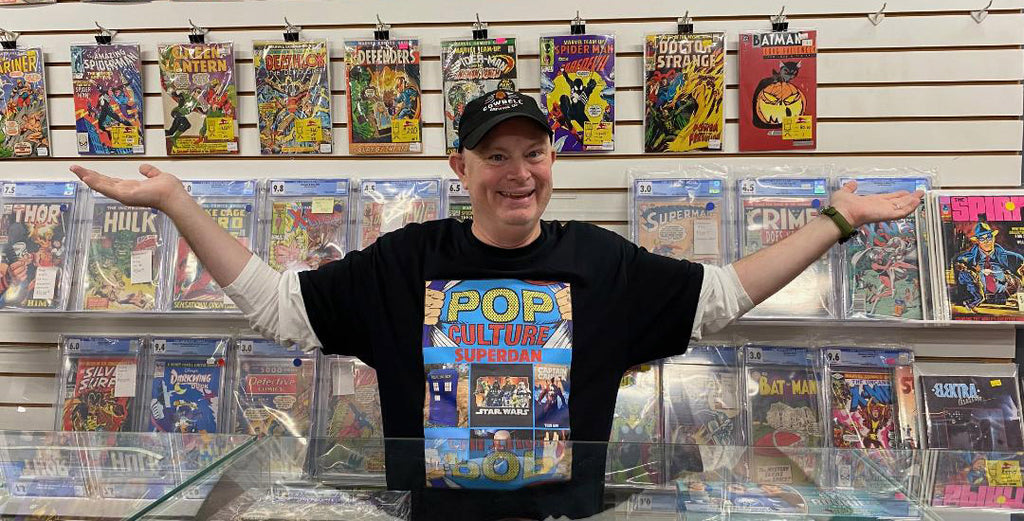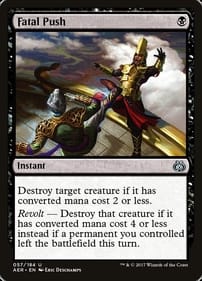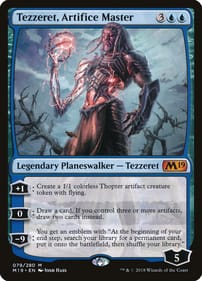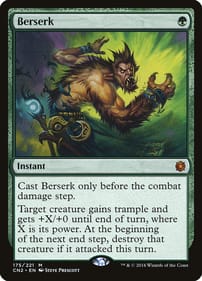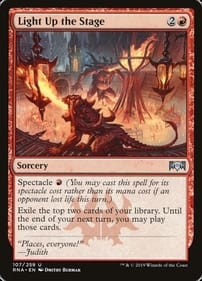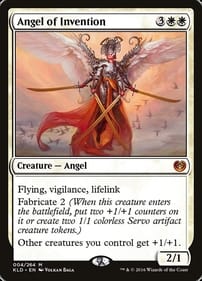Will New Crossovers Keep It Fresh?
By Dan Brown Incoming! A new batch of DC/Marvel collaborations begins landing in comic stores this month. As old comic fans like me well know, crossovers are an age-old marketing tradition. The question is: Can the combined talent of comicdom’s two industry leaders make them feel fresh and exciting in 2025? The collabs, one published by each company, were announced in February. L.A. Mood’s Matt Finch alerted me they were in the pipeline because he knew I would remember the ones from the 1970s and onward. Those stories take place out of regular continuity. That allows the legal wall between DC and Marvel to be torn down, the result being Superman can team up with Spider-Man, the New Teen Titans with the X-Men, Batman with the Hulk, and so on. Crossovers were once rare, momentous events. When I cast my mind back to the 1970s, I still remember being stunned at the sight of the Man of Steel and Spidey squaring off on the cover of the same comic. Although I was just a dumb kid, I understood this was something special that didn’t happen every month. That’s probably why I grabbed every crossover – typically printed in a larger format – that came my way. Since these special issues sold so well, they quickly evolved into a cottage industry within the larger comics business, and as more independent publishers popped up, those new players tried to grab a piece of the action. Batman has co-starred with Judge Dredd. Archie met the Predator once. The Teenage Mutant Ninja Turtles have taken on Flaming Carrot. Flash-forward to this year, and Godzilla seems to be omnipresent in comics, breathing fire and stomping skyscrapers in every publisher’s imaginative universe. Crossovers represent an extension of the idea of continuity: If every Marvel superhero exists in the same metaverse together, why can’t they exist alongside DC’s stable of stars as well, at least temporarily? The first of the new books will see Deadpool face off against the Dark Knight, with backup stories combining Daredevil and Wonder Woman, and Krypto and Jeff the Land Shark, in the same volume. Along those lines, this summer I found an old Wizard magazine from 1994 in a second-hand bookstore. Among the then-current industry news was a brief touting an upcoming Batman/Punisher outing. That’s how ubiquitous they became. It was from those earlier crossovers that I was first introduced to such characters as the Jack Kirby-created baddie Darkseid. (Lord knows I love Walter Simonson’s art, but how did George Perez not get the assignment when the Titans met the X-Men in 1982?) So that particular volume was instrumental in introducing each company’s fans to the other’s lineup of characters. Crossovers became a way of cross-pollinating different fandoms. Those who loved both of this summer’s big-screen superhero outings – Superman and The Fantastic Four: First Steps – may be surprised to learn that Supes was, like the Silver Surfer, once a herald of Marvel planet-eater Galactus. Yep, it happened in 1999’s Superman/Fantastic Four: The Infinite Destruction, one of the best dual efforts from back in the day. Speaking of the movies, if it’s really true that audiences are finally tiring of superhero stories, how long will it be before one of the big brains in Hollywood suggests using the same strategy on the silver screen that has worked in comics? Isn’t that the logical next step – putting unlikely heroes beside each other to sell movie tickets? I’m betting it’s only a matter of time. If the Alien and the Predator can slug it out, why not put DC heroes and Marvel’s finest beside one another in a motion picture? Indeed, how long until a single mega-company – think Disney – assembles all the characters it owns from different media in the same movie adventure? Admit it: You love the idea of Luke Skywalker partnering with Tony Stark to fight the combined villainy of Darth Vader and Doctor Doom! Dan Brown has covered pop culture for more than 33 years as a journalist and also moderates L.A. Mood’s monthly graphic-novel group.
New Volume Of Public Domain Deepens, Enriches Tale Of Competing Creators
By Dan Brown Out this month, the second volume of Chip Zdarsky’s Public Domain graphic novel is a rare thing. It’s a sophomore collection that enriches the storyline of an ongoing comic series, putting the characters in new and surprising situations. Subtitled Build Something New, it grabbed my attention, then left me wanting more.If you haven’t checked it out, Public Domain tells the story of two aging comic creators.One, the writer, is lionized by fans of pop culture who adore him at comic conventions. The other, the artist, is held in high regard by comic purists but got shafted after helping to create an enduring character that has spawned a multimedia empire, including big-screen adaptations. If that sounds like Stan Lee and Jack Kirby to you, that’s because it’s supposed to. Here the Lee figure is the crusty Jerry Jasper and the Kirby equivalent is Syd Dallas. The launching point for the first volume, collecting the initial four issues of Public Domain, was something like, “What if Jack Kirby had got legal control of the characters he drew for Marvel Comics in the 1960s?” Like Lee, Jasper’s talents as a scribe are questionable and his true talent is self-promotion. Like Kirby, Dallas was an influential artist but doesn’t get enough props for the pioneering work he did back in the day. A superhero named the Domain is the duo’s most famous creation. When the series begins, the Domain is the centrepiece of the Singular Comics empire, which includes any number of slick, special-effects driven motion pictures. The face of the actor who plays him is plastered on billboards, buses, you name it. The fact Dallas is forgotten except by the most diehard fans doesn’t sit well with his two sons. After a legal knife fight, Dallas gets the rights to produce Domain comics back, and having missed most of their childhood because he was metaphorically chained to the drawing table, Dallas wants to make the return of his Domain to the printed page a family affair. This leads to a situation that would have delighted many real-life comic fans: Both creators can publish their own versions of the character. In Build Something New, the reader sees the beginnings of a fresh battle, as the former partners prepare to go head-to-head. The second volume goes way beyond the initial premise. The story deepens, broadens, and gets even richer. As in the first Public Domain anthology, there are many twists, almost every one unanticipated by me – which I love. Zdarksy, a Canadian artist/writer, is firing on all cylinders here. His art is economical. His dialogue is lively. The established characters are well on their way to being fully fleshed out, so he introduces interesting new ones. Part of this volume takes place in the 1980s, and those segments had a melancholy-yet-energetic feel that, for whatever reason, reminded me of the flashbacks in the landmark DC series, Watchmen. And even though Public Domain was inspired by actual comics history, Zdarsky keeps the industry in-jokes to a minimum. If you’re at all interested in stories about the people behind the superheroes you love, you should read this new graphic novel. In fact, do yourself a favour: Get BOTH volumes of this engrossing series – the one just published and the previous collection as well. You’ll thank me. Dan Brown has covered pop culture for more than 32 years as a journalist and also moderates L.A. Mood’s monthly graphic-novel group.
Recommended Remembrance Day Reading
By Dan BrownIf you ask me, Remembrance Day should be a statutory holiday – I believe this country ought to grind to a halt out of respect for those who gave their lives so the rest of us could live in peace.And in no way do I think reading a comic or graphic novel can come anywhere close to recreating the brutality of combat. So I mean no disrespect by offering these ideas for Remembrance Day reading. Please consider these suggestions a starting point, and nothing more.Two Generals: Created by Southwestern Ontario’s own Scott Chantler, this moving book gives a grunt’s-eye-view of the D-Day landings. It’s based on Chantler’s own family history and his crisp lines don’t diminish the horrors of war. Jack Kirby: The Epic Life of the King of Comics: Not only did Jack Kirby draw many war comics, but he was also an actual U.S. soldier who landed at Normandy (in a subsequent wave). I recommend Tom Scioli’s biography because it helped me visualize Kirby’s contribution to the war effort. All Quiet on the Western Front: Wayne Vansant’s graphic adaptation of the classic Erich Maria Remarque novel pulls no punches with its detailed account of trench warfare and forays into No Man’s Land as told from the German side. Vansant is himself a veteran of the Vietnam War.The Canadian Whites: These were the wartime comics that flourished in Canada during the Second World War due to restrictions the government put on imports. Hard to believe, but our dominion had a thriving homegrown comic industry in those years. I would suggest you start with Nelvana of the Northern Lights, a collection about a female goddess who fought Nazis and also beat Wonder Woman to market.Berlin: This expansive volume by Jason Lutes depicts what was going on in the German city between the wars. The cast combines historical figures like Hitler with fictional characters and was years in the making. It opened my eyes.They Called Us Enemy: Inspired by the true story of Star Trek actor George Takei’s family, this tale of the homefront describes how Japanese Americans were sent to internment camps during the Second World War. This, after their possessions were confiscated and their businesses liquidated. There are echoes of this experience in the short comic Junban by Toronto creator Jillian Tamaki. It first appeared in the New Yorker and describes her grandfather’s parallel experience in British Columbia.Sgt. Fury and His Howling Commandos: Long before he was an agent of SHIELD, Fury – the comic one, not the one played by Samuel L. Jackson – was fighting Nazis in the pages of Marvel Comics. Any introductory collection will do, and yes, I know these comics were meant more as entertainment for boys than a serious record of how World War Two unfolded. Captain America’s earliest adventures are likewise worth a read – Cap was punching Hitler in the face before the U.S. had even been drawn into the war.Sgt. Rock: A DC anthology like Archives Volume One will give you the idea. The highlight here is Joe Kubert’s gorgeous art, which was also featured in another World War Two title from DC, the Unknown Soldier.Please consider these recommendations in the spirit they're offered. Every one of us has to begin learning about war somewhere, and for me it was in the pages of comics like these.Dan Brown has covered pop culture for more than 32 years as a journalist and also moderates L.A. Mood’s monthly graphic-novel group.
The Marvel Universe: An appreciation
By Dan Brown Did you ever have one of those posters showing all the Marvel superhero characters gathered together in one place? Over the decades, successive generations of Marvel artists have depicted that crowded scene – row after row of colourful do-gooders, a cast of literally thousands, standing at the ready to fight evil.. Whether this heroes’ gallery was drawn by Jack Kirby, John Byrne or Michael Golden or someone else, my jaw hits the floor every time I see it. I am in awe of the creative energy it must have required to come up with backstories and costumes for all of them. So what I want to do this week is take a moment to praise the folks at Marvel for doing such a good job of churning out one interesting character after another since 1939. This will come as no surprise to regular readers who know I was raised on Marvel Comics in the 1970s. (And don’t worry, DC fans, I’ll do a tribute to that company’s stable when I figure out the right way to do it.) When it comes to being prolific, no other comic publisher has the track record Marvel does. What a riot of invention! What a unique assemblage of talent! What a big bang of creativity that set and kept the Marvel Universe in motion! The Marvel Universe is what results when the right talented people get together and are allowed the freedom to let their minds wander. It’s an example of what no less an authority than Willy Wonka calls “pure imagination.” Jack Kirby and Stan Lee – who launched such comics as the Avengers, the Fantastic Four, the Incredible Hulk and the Uncanny X-Men – were undeniably the creators among creators at Marvel. I don’t want to get too much into the weeds on the question of which man possessed the real vision, so let’s just state for our purposes here today that Kirby and Lee combined are among the greatest and most prolific American originators of characters, in the same league as Walt Disney, Jim Henson, Dr. Seuss and Mark Twain. It’s true the different creative teams at Marvel were motivated by economic necessity. They never met a trend they didn’t try to plunder, like the disco craze. No sooner, it seemed, had Studio 54 opened than Marvel came up with the mutant Dazzler – who has all the powers of a disco ball! When kung fu movies likewise hit it big, Marvel answered with Shang-Chi and Iron Fist. Sometimes the plundering was done for the right reasons, as when characters like Black Panther and Power Man were devised to give black readers heroes of their own. Although some fans have by now grown weary of the offerings from Marvel’s movie division, the studio hasn’t even begun to scratch the surface of the vast library of characters it owns. No one would call the comic-book Agatha Harkness a major Marvel character, but there’s currently an entire series streaming right now devoted to her solo adventures. A series about Wonder Man – another B-list character – is set to debut next year. As someone who appreciates and values imagination, I can’t help but be deeply impressed by how productive Marvel has been over the decades, creating a surplus of diverse characters who have now become recognized around the world. And yes, the chumminess of the Marvel Bullpen was likely an illusion created by Lee to help infuse the Marvel brand with an air of fun, but at the end of the day we are still left with what all of those artists, writers, colourists, letterers and editors wrought: An entirely original group of compelling heroes. There’s literally a character for everyone. I stand in awe. Dan Brown has covered pop culture for more than 31 years as a journalist and also moderates L.A. Mood’s monthly graphic-novel group.
Upcoming Omnibus Volumes Feature Comics from Marvel’s Michael Golden Age
By Dan Brown There’s a whole lotta classic Michael Golden art coming down the pipeline. I invite young comic fans who missed out on Golden’s most-celebrated work in the 1980s to check out two omnibus editions set to debut early next year. They feature reprinted issues from two series that kicked off in 1979 – ROM: Spaceknight and The Micronauts – then ran into the mid-1980s. If you want to understand why fiftysomething dudes like me always seem to be bellyaching about how comics reached perfection when we were kids, these books are Exhibit A. In my memory, Golden’s pencils leapt off the page with undeniable power and expressiveness. He could take obscure Marvel comic characters and make them memorable. He could make alien landscapes seem truly otherworldly, as few pencillers – think George Perez and Jack Kirby – did. Golden was never the interior artist on ROM, but he did contribute a series of amazing front covers in the title’s early going. A toy tie-in with Hasbro, ROM followed the exploits of a galactic do-gooder who comes to Earth to dispatch the evil Dire Wraiths. Having those shape-shifters as foes imbued the series with a vibe straight out of Invasion of the Body Snatchers. Of course, the ironic part is how another race of Marvel shape-shifters, the Skrulls, had already been trying to take over the planet, so the Wraiths were kind of redundant. I especially love the cover of issue 11, which shows the silver spaceknight ripping the wing from an F-16 in mid-air as a squad of the planes swarms him. Golden’s art had started to make an impression on me earlier in 1979 with the Micronauts. I was 11 years old. He illustrated the first 12 issues of that title, also designed to push the toy line of the same name, and I now view his pencils on the book as one of the great runs in comic history, in the same category as Perez’s time on New Teen Titans and John Byrne’s pencils for the Uncanny X-Men. The cover of each issue blared “They came from inner space” and the action took place on a sub-microscopic scale; what in our world are tiny molecules, were planet-sized in the Microverse. It’s true the premise wasn’t bursting with originality: A band of plucky rebels, including two robots, fights to free a galaxy in the iron grip of a villain clad in black armour. But Golden’s art elevated the material. Especially moving was issue 10, in which the warrior Acroyear race – as well as the conscious homeworld they inhabit, Spartak – repulses an army of Baron Karza’s dog soldiers. If the Microverse sounds familiar, it’s because it plays a huge role in the Marvel Cinematic Universe, where it’s known as the Quantum Realm. The biggest mystery to me was why, with the rare exception of standalones like Avengers Annual No. 10 in 1981, Golden wasn’t allowed by Marvel to play with the company’s marquee characters. I guess not every comic creator is destined to go down in history as being as prolific as Kirby. ROM: The Original Marvel Years Omnibus Volume 1 includes the first 29 issues of ROM: Spaceknight, as well as Power Man and Iron Fist No. 73, in which he guest-starred. Micronauts: The Original Marvel Years Omnibus Volume 1 collects the first 29 issues of the series, plus the first two annuals. Both go on sale in January. Dan Brown has covered pop culture for 30 years as a journalist and also moderates L.A. Mood’s monthly graphic-novel group.




